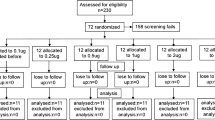Abstract
The ability of spherule-derived coccidioidin containing 0.4 % phenol and 0.0001 % thimerosal in buffered saline to induce delayed-type hypersensitivity (DTH) was evaluated in four separate studies. The skin test antigen was titrated in 20 adult volunteers with a recent history of pulmonary coccidioidomycosis using intradermal doses of 0.4, 0.8, and 1.6 μg of antigen, based on total dry weight. Based on these data, a dose of 1.27 μg was shown to elicit a mean ± SEM induration response of 23.5 ± 2.3 mm at 48 h, similar to the 23.6-mm response after 48 h of the U. S. Reference coccidioidin last tested approximately 13 years ago. The 1.27 μg dose in 0.1 mL of the spherule-derived antigen (Spherusol) was then examined in three separate groups of adult volunteers to determine the sensitivity and specificity of the product. Fifty-nine of 60 individuals living in a non-endemic area for coccidioidomycosis were skin test negative to Spherusol. Twelve subjects with a recent history of pulmonary histoplasmosis were skin test negative to Spherusol. Finally, 51 of 52 individuals with a recent diagnosis of acute pulmonary coccidioidomycosis were skin test positive to Spherusol. Within this group, prior therapy with fluconazole did not appear to reduce the reactivity to Spherusol. No serious adverse events were observed in the four studies. From these data, Spherusol was found to be safe and has an overall observed sensitivity and specificity of ≥98 % in detecting DTH in coccidioidomycosis.
Similar content being viewed by others
References
Pappagianis D. Epidemiology of coccidioidomycosis. Curr Top Med Mycol. 1988;2:199–238.
Galgiani JN, Ampel NM, Blair JE, Catanzaro A, Johnson RH, Stevens DA, et al. Coccidioidomycosis. Clin Infect Dis. 2005;41:1217–23.
Smith CE, Beard RR, Whiting EG, Rosenberger HG. Varieties of coccidioidal infection in relation to the epidemiology and control of the diseases. Am J Public Health. 1946;36:1394–402.
Smith CE, Whiting EG, Baker EE, Rosenberger HG, Beard R, Saito MT. The use of coccidioidin. Am Rev Tuberc. 1948;57:330–60.
Ampel NM. Measurement of cellular immunity in human coccidioidomycosis. Mycopathologia. 2003;156:247–62.
Oldfield EC III, Bone WD, Martin CR, Gray GC, Olson P, Schillaci RF. Prediction of relapse after treatment of coccidioidomycosis. Clin Infect Dis. 1997;25:1205–10.
Emmett J. Coccidioidin sensitivity among school children in Phoenix (skin test and X-ray survey). Am J Public Health. 1952;42:241–5.
Edwards PQ, Palmer CE. Prevalence of sensitivity to coccidioidin, with special reference to specific and nonspecific reactions to coccidioidin and histoplasmin. Dis Chest. 1957;31:35–60.
Catanzaro A. Coccidioidin sensitivity in San Diego schools. Sabouraudia. 1979;17:85–9.
Dodge RR, Lebowitz MD, Barbee R, Burrows B. Estimates of C. immitis infection by skin test reactivity in an endemic community. Am J Public Health. 1985;75:863–5.
Larwood TR. Coccidioidin skin testing in Kern County, California: decrease in infection rate over 58 years. Clin Infect Dis. 2000;30:612–3.
Fredrich BE. A skin test survey of valley fever in Tijuana, Mexico. Soc Sci Med. 1989;29:1217–27.
Padua y Gabriel A, Martinez-Ordaz VA, Velasco-Rodreguez VM, Lazo-Saenz JG, Cicero R. Prevalence of skin reactivity to coccidioidin and associated risks factors in subjects living in a northern city of Mexico. Arch Med Res. 1999;30:388–92.
Drutz DJ, Catanzaro A. Coccidioidomycosis. Part I. Am Rev Respir Dis. 1978;117:559–85.
Levine HB, Cobb JM, Scalarone GM. Spherule coccidioidin in delayed dermal sensitivity reactions of experimental animals. Sabouraudia. 1969;7:20–32.
Levine HB, Gonzalez-Ochoa A, Ten Eyck DR. Dermal sensitivity to Coccidioides immitis. A comparison of responses elicited in man by spherulin and coccidioidin. Am Rev Respir Dis. 1973;107:379–86.
Stevens DA, Levine HB, TenEyck DR. Dermal sensitivity to different doses of spherulin and coccidioidin. Chest. 1974;65:530–3.
Levine HB, Restrepon A, Eyck DR, Stevens DA. Spherulin and coccidioidin: cross-reactions in dermal sensitivity to histoplasmin and paracoccidioidin. Am J Epidemiol. 1975;101:512–6.
Biological products; Bacterial vaccines and related biological products; Implementation of efficacy review; Proposed order. Federal register. 2000;65:31003–10.
Overholser BR, Sowinski KM. Biostatistics primer: part 2. Nutr Clin Pract. 2008;23:76–84.
Altman DG, Bland JM. Diagnostic tests. 1: sensitivity and specificity. BMJ. 1994;308:1552.
Simel DL, Samsa GP, Matchar DB. Likelihood ratios with confidence: sample size estimation for diagnostic test studies. J Clin Epidemiol. 1991;44:763–70.
McCall RB. Fundamental statistics for behavioral sciences. Stamford: Thomas Learning, Inc.; 2001.
Cox NH, Forsyth A. Thimerosal allergy and vaccination reactions. Contact Dermat. 1988;18:229–33.
Goncalo M, Figueiredo A, Goncalo S. Hypersensitivity to thimerosal: the sensitizing moiety. Contact Dermat. 1996;34:201–3.
Flynt PL, Sinski JT, Kelley LM. Coccidioidin and merthiolate in previously sensitized animals. Infect Immun. 1975;11:52–6.
Galgiani JN. Development of dermal hypersensitivity to coccidioidal antigens associated with repeated skin testing. Am Rev Respir Dis. 1986;134:1045–7.
Ampel NM, Hector RF, Lindan CP, Rutherford GW. An archived lot of coccidioidin induces specific coccidioidal delayed-type hypersensitivity and correlates with in vitro assays of coccidioidal cellular immune response. Mycopathologia. 2006;161:67–72.
Acknowledgments
The design and implementation of this study were supported by Allermed Laboratories, Inc., of which H.S. Nielsen is president. None of the other authors have a financial interest in Allermed Laboratories or in spherule-based coccidioidin.
Author information
Authors and Affiliations
Corresponding author
Rights and permissions
About this article
Cite this article
Johnson, R., Kernerman, S.M., Sawtelle, B.G. et al. A Reformulated Spherule-Derived Coccidioidin (Spherusol) to Detect Delayed-Type Hypersensitivity in Coccidioidomycosis. Mycopathologia 174, 353–358 (2012). https://doi.org/10.1007/s11046-012-9555-6
Received:
Accepted:
Published:
Issue Date:
DOI: https://doi.org/10.1007/s11046-012-9555-6




